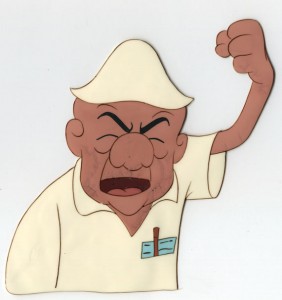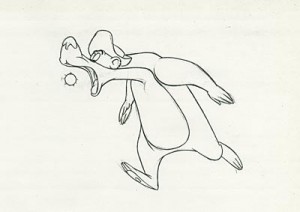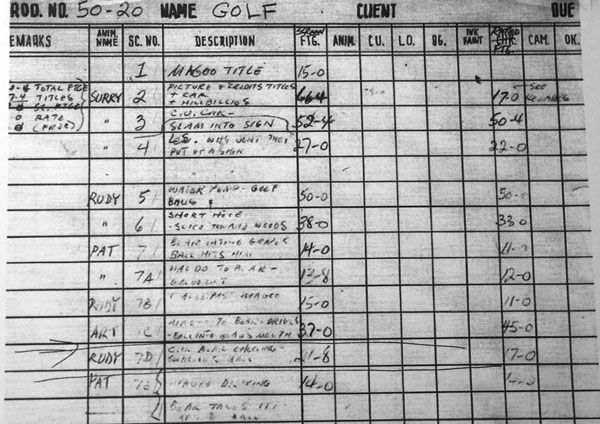What’s that? A UPA draft, featuring Mister Magoo? Your eyes certainly don’t deceive you like old Magoo’s…

In early 1948, United Productions of America (UPA), an animation studio which produced industrial and training films during World War II, negotiated a deal with Columbia Pictures to release four theatrical cartoons on a trial basis. Under Columbia’s insistence, the studio continued with their long-running Screen Gems characters The Fox and the Crow in Robin Hoodlum (1948) and The Magic Fluke (1949), directed by John Hubley, vice president and creative head of the company. These first two releases each received an Oscar nomination. For their next film, John Hubley and budding screenwriter Millard Kaufman created an obstinate, and nearsighted, human character named Mister Magoo for The Ragtime Bear (1949).
 Magoo’s petulance was inspired by Hubley and Kaufman’s respective uncles—on their accounts, they were both intolerant, opinionated men. Actor Jerry Hausner, voice of Magoo’s nephew Waldo in several cartoons, including this film, recommended radio actor Jim Backus for Magoo. Backus, known for performing his character Hubert Updike III on The Alan Young Show, derived Magoo’s traits from his wealthy industrialist father Russell Gould Backus. His father, quite similar to Hubley and Kaufman’s uncles, resented being corrected for his mistakes.
Magoo’s petulance was inspired by Hubley and Kaufman’s respective uncles—on their accounts, they were both intolerant, opinionated men. Actor Jerry Hausner, voice of Magoo’s nephew Waldo in several cartoons, including this film, recommended radio actor Jim Backus for Magoo. Backus, known for performing his character Hubert Updike III on The Alan Young Show, derived Magoo’s traits from his wealthy industrialist father Russell Gould Backus. His father, quite similar to Hubley and Kaufman’s uncles, resented being corrected for his mistakes.
Before Magoo, the Popeye series, produced by the Fleischer and Famous Studios, served as animation’s standard for the depiction of human characters. Whereas Popeye the Sailor was portrayed as a homely, but benevolent spirit, Magoo’s early appearances reveal a cantankerous, persistent demeanor. Like Jack Mercer for Popeye, Backus often improvised lines of dialogue during the recording sessions. UPA’s success with Magoo persuaded Columbia to sign a long-term contract with the company. Magoo was given his own series. However, Columbia demanded six cartoons a year from UPA, so Hubley couldn’t direct each title.
Pete Burness desired to become a director at UPA, and Hubley chose not to direct a continuing series, wanting to experiment with new cartoons. Burness was promoted to director under Hubley’s supervision. Burness was more qualified an animator than his superior, and had worked for several studios including Romer Grey, Ted Esbaugh, Van Beuren, MGM and Warners. Magoo’s character changed under his direction—still stubborn, but more cordial. However, the early Magoos directed or supervised by Hubley have great inventiveness in their characterizations. The series quickly congealed into a formula, centered on Magoo’s near-sightedness, which ultimately worsened when Hubley was fired from UPA in 1952.
 Columbia encouraged UPA to use animal characters, since the moviegoing public favored talking animal characters in other studios’ cartoons. In this film, the grizzly bear, appearing much like the titular Ragtime Bear, acts like an animal here, but with some implausible qualities. In scene 16 (animated by Art Babbitt), the bear chases after a dandelion, mistaking it for a golf ball, in an almost balletic grace. Babbitt recalled this sequence as one of his favorites, as did Pete Burness.
Columbia encouraged UPA to use animal characters, since the moviegoing public favored talking animal characters in other studios’ cartoons. In this film, the grizzly bear, appearing much like the titular Ragtime Bear, acts like an animal here, but with some implausible qualities. In scene 16 (animated by Art Babbitt), the bear chases after a dandelion, mistaking it for a golf ball, in an almost balletic grace. Babbitt recalled this sequence as one of his favorites, as did Pete Burness.
Besides Babbitt, animators Cecil Surry, (an uncredited) Pat Matthews and Rudy Larriva handle much of the footage in Grizzly Golfer. Before moving to UPA, Larriva was considered one of Chuck Jones’ top animators at Warners in the mid-‘30s and early ‘40s. He left Warners to serve in the First Motion Picture Unit, and was recommended a position at Disney’s by animator Frank Thomas. He briefly animated for the studio in the mid-‘40s on films such as Song of the South (1946), Melody Time (1948) and The Adventures of Ichabod and Mr. Toad (1949). There is an odd camera cut, in scenes 7B and 7C, in which the bear has a golf ball stuck between his teeth; the background remains the same, but the different character poses (one by Babbitt, the other by Larriva) move slightly, indicating the cut.
The draft for Grizzly Golfer was sourced from the papers of Pete Burness; however, the document has only partial animator credits. The document also cuts off around the final sequences of Waldo retrieving the rifle and the hillbillies shooting at him and Magoo at the end of the film. There is a small amount of discrepancies in the draft, too; scenes 7 and 7A are actually animated by Babbitt, not Matthews. The absent assignments, including the last portions of the film, are indicated in the video from judging the drawing/animation of the credited artists. It also designates sequences omitted in the film, such as Magoo hitting a divot and replacing it (scenes 11 and 12) and Magoo hitting a rock (scene 15). The written inscriptions are faint and hard to decipher, so a few are transcribed here:
Scene 7: “Bear eating grapes (excised from film) — Ball hits him”
Scene 7A: “Waldo to bear — Waldo out”
Scene 7B: “Waldo past Magoo”
Scene 7C: “Magoo to bear — Drives ball into bear’s mouth”
Scene 7D: “C.U. Bear chewing — Swallows ball”
Scene 7E: “Magoo driving” — “Bear takes off after ball”
It’s nice to have a draft from a different studio, isn’t it? Hopefully, similar documents from UPA will someday surface. Till then, enjoy the breakdown video!



(Thanks to Adam Abraham, Patrick Malone, Mike Kazaleh, Frank Young, Jerry Beck and Michael Barrier for their help.)


 DEVON BAXTER is a film restoration artist, video editor, and animation researcher/writer currently residing in Pennsylvania. He also hosts a
DEVON BAXTER is a film restoration artist, video editor, and animation researcher/writer currently residing in Pennsylvania. He also hosts a 





















































































If I remember correctly, my introduction to MR. MAGOO probably began with the TV version of the character, although there were occasional Saturday matinees at our local movie theater, and MAGOO theatricals were featured among the toons. I always liked the character, even in his TV days because of the situations. The UPA artists probably grew to hate the character because they were never fond of repeating any formula at all, but they always came up with extremely funny situations to challenge Mr. Magoo! Ouch!
Yeah, for me it was the original VHS tapes of the Columbia shorts my mom rented from a store in the 80’s where I first saw the titular guy from.
Yep, I believe Hubley didn’t like funny animal characters and had to reluctantly use the Fox and the Crow for only two outings (At least for this and The Ragtime Bear, the titular animals were a little more animal-like in appearance and movement). After that, U.P.A just struck with humans (and fine modern art).
Pretty much, animals just never got a break since.
There was also Jack, the talking (and heavily stylized) horse in Giddyap (1950).
I’m hopeful that Zootopia will serve as a reminder that funny animals can be used for more than animal-based puns and cuteness, and that its success will encourage other artists and writers to explore their potential for storytelling.
Too bad it took quite along time to get to this point Jody.
” OH DEVON, YOU’VE DONE IT AGAIN ” !!! Great post of my favorite old codger. I think the older I get the more I’m identifying with the early cantankerous Magoo. Keep up the GOOD work.!
Sorry. It should be three outings (you forgot to mention 1950’s Punchy De Leon).
Yep, UPA knocked out three Fox & Crows before calling it quits for the duo. It’s interesting watching these and notice how quickly they ditched Fox’s tail by the second cartoon.
Sure wish I knew the actors hired for the two hunter voices…I’ve listened enough to convince myself it’s not Hausner and Backus doubling. In the first year, Hubley hired various screen and radio actors. When I was researching my Ward book, Al Shean told me that Hub was very determined that, “we don’t want that Mel Blanc syndrome happening here.” Although in the later years of Magoo theatricals Daws Butler did a lot of support roles, the studio was still using several one-off actors who rarely did cartoons.
Shame they never kept records of that I suppose.